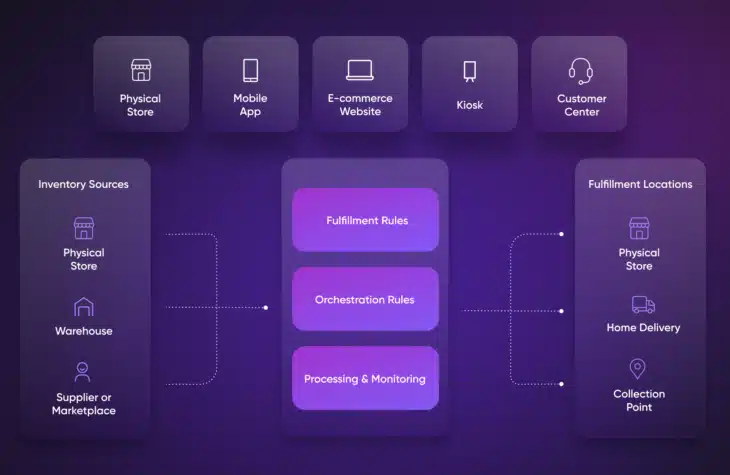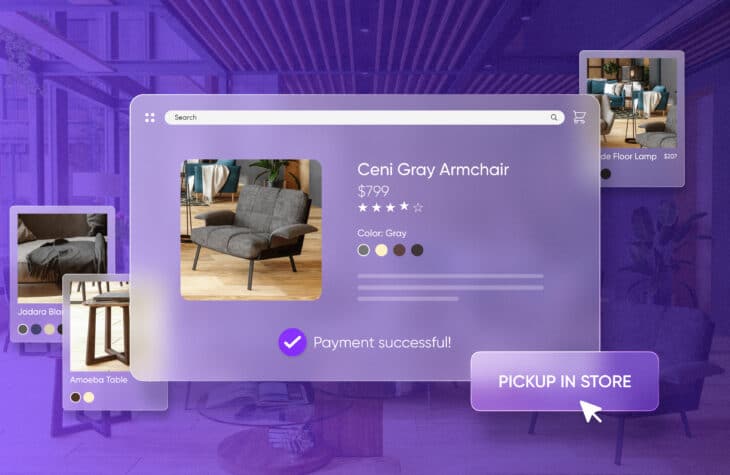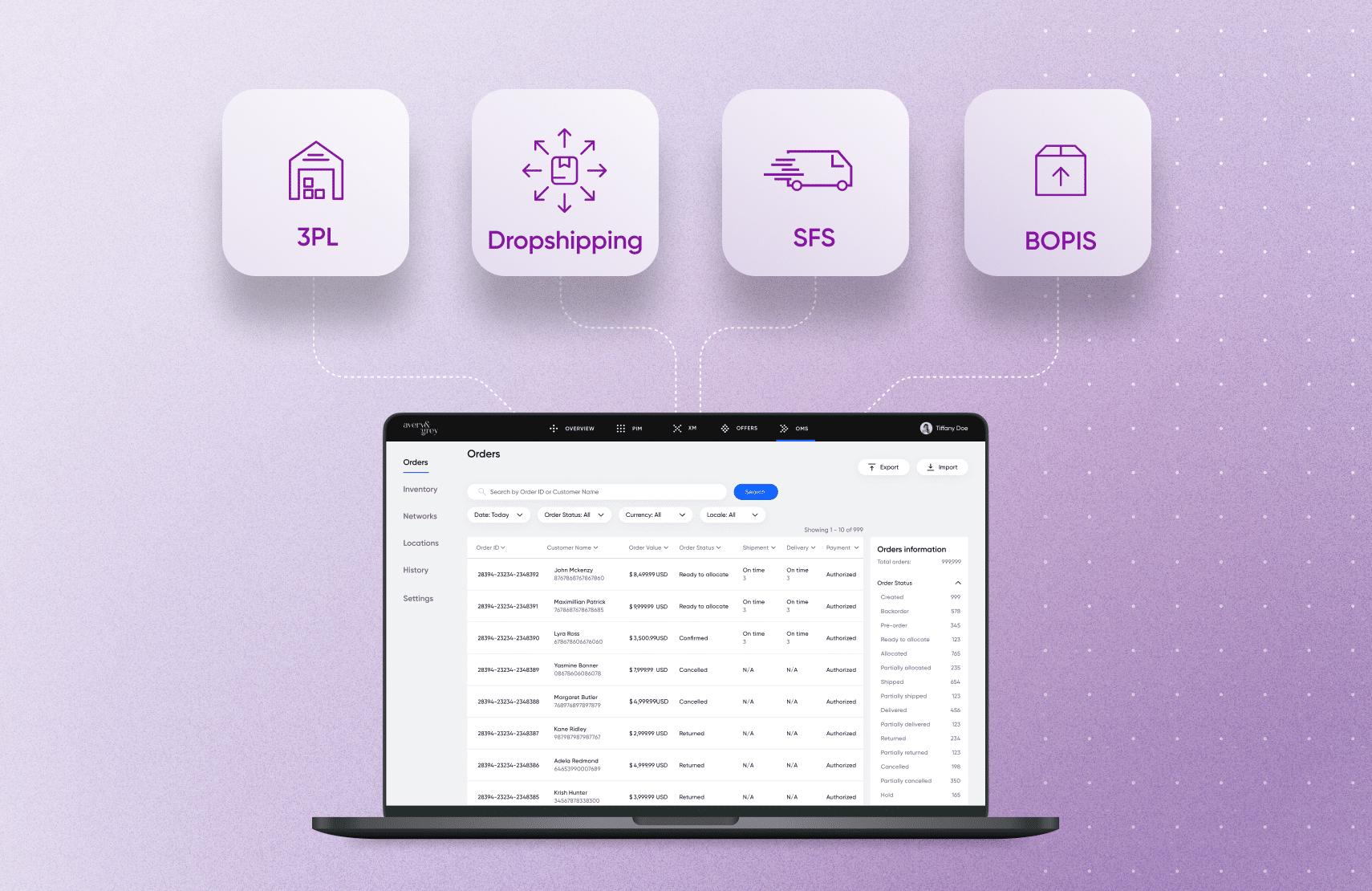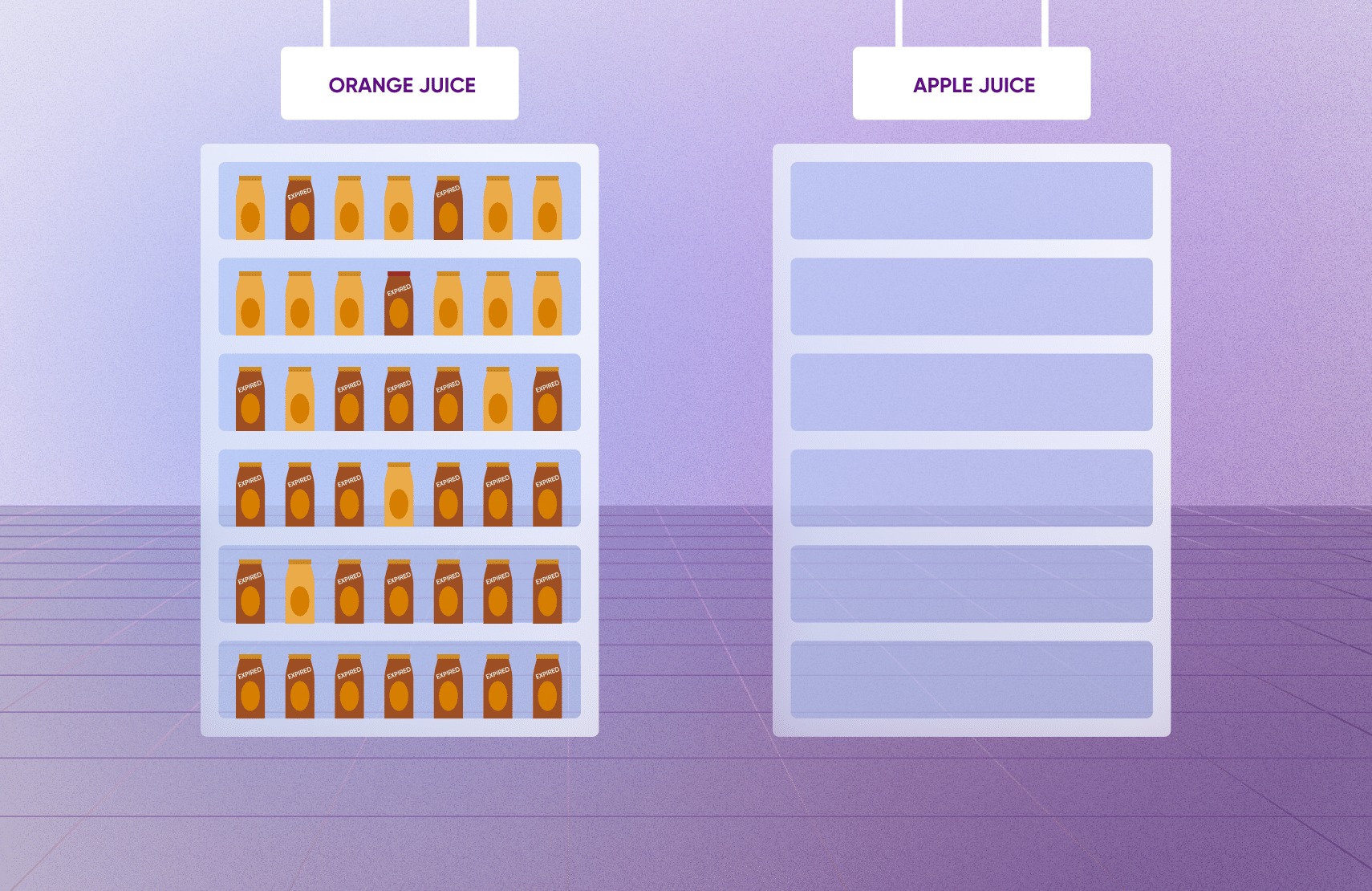What is Curbside Pickup? A Key Omnichannel Fulfillment Strategy Explained

Curbside pickup is a contactless fulfillment strategy that enables customers to order products online and collect them at a designated location outside the store.
The benefits of offering curbside pickup to customers include lower shipping costs, increased customer loyalty and retention, higher sales, and optimized inventory management.
Retailers should follow best practices for curbside pickup, including using a distributed order management system (OMS) to manage orders, inventory, and fulfillment.
fabric OMS is built for complex enterprise retail operations and supports omnichannel fulfillment models, including curbside pickup and buy online, pickup in-store (BOPIS).
Before the rise of omnichannel fulfillment, the act of someone handing you an order in your vehicle was mostly limited to drive-in restaurants and drive-thru windows. Yet today, curbside pickup has quickly become one of the more popular fulfillment strategies offered by omnichannel e-commerce retailers and it has transformed the way customers interact with businesses, providing a more seamless and convenient shopping experience.
Curbside pickup gained steam during the COVID-19 pandemic as a way to maintain an elevated customer experience while keeping customers and staff safe. In the time of social distancing, contactless pickup was a highly effective way to get products to customers without risking anyone’s health and safety.
In early 2020, only 6.6% of the Top 1,000 retail chains in the U.S. offered curbside pickup, but by the end of 2021, that number soared to a whopping 61.8%. Interestingly, mass adoption has been driven by the millennial population (people that are born between 1981 to 1996). In 2022, Statista reported that nearly two-thirds of US millennial consumers chose curbside pickup for their online purchases.
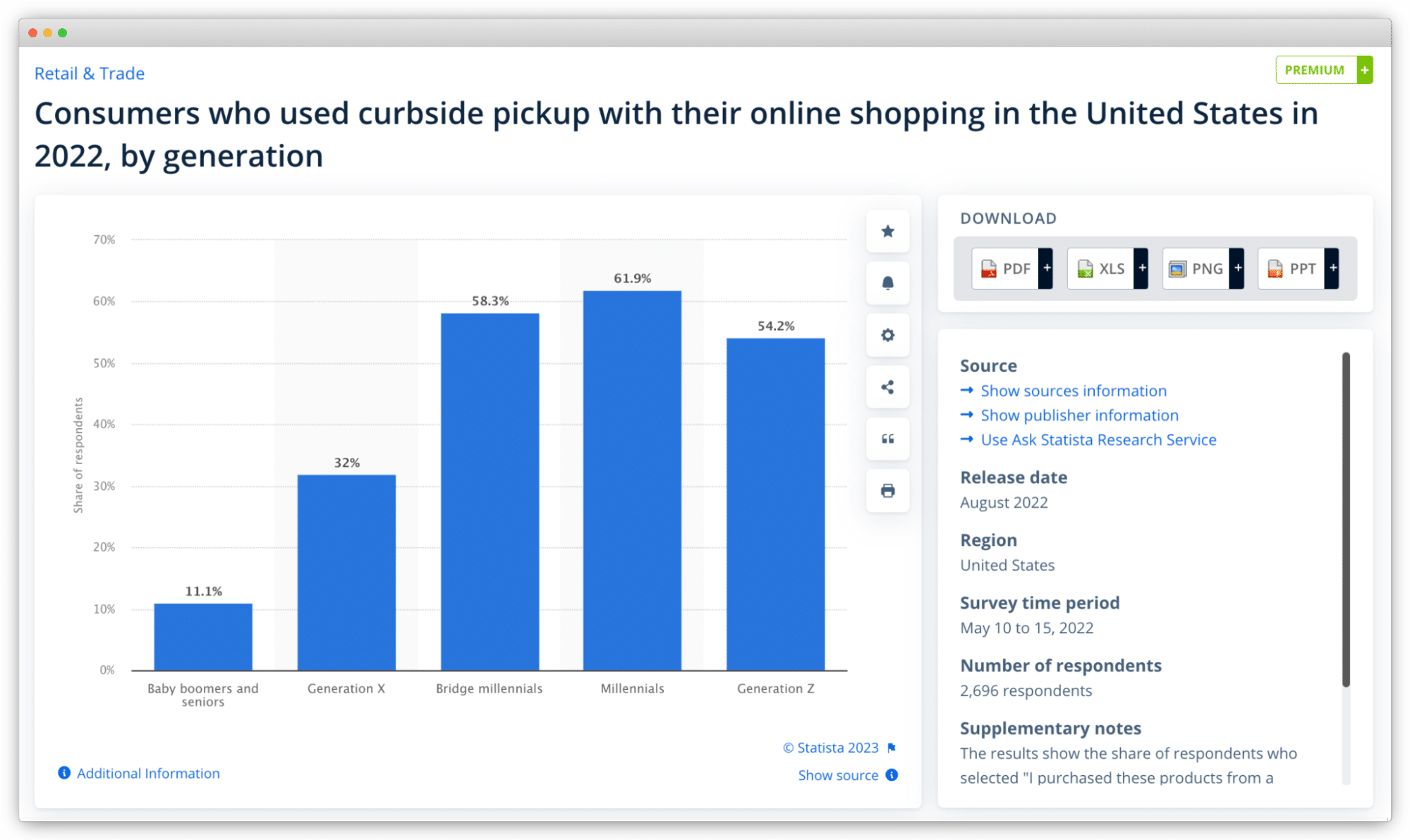
Large retailers are winning with curbside pickup
Retail behemoths like Walmart, Best Buy, and Target have found great success with the implementation of curbside pickup as an omnichannel fulfillment strategy.
For example, at the start of the COVID-19 pandemic, Best Buy partnered with AWS to deploy an industry-leading curbside pickup experience in just two days. Today, their curbside pickup program continues to power innovative shopping experiences, such as Best Buy’s new “Experience Stores” and livestream shopping features with expanded curbside pickup areas and 24/7 pickup lockers.
Walmart is equally as invested in curbside pickup, introducing ‘No Concerns’ returns last holiday season to allow customers to remain in their vehicles when returning items. Earlier this year, Walmart launched a dedicated e-commerce site for small and medium business customers to simplify business-related purchases, like office supplies, furniture, electronics, and snacks. These business purchases are all available for curbside pickup. In a recent earnings call, Walmart CFO John Rainey said that Sam’s Club e-commerce sales grew 21% year over year, which he attributed to curbside pickup and ship-to-home sales.
Meanwhile, Target’s Drive Up program has become wildly successful in its own right. It is now the company’s top-rated fulfillment service. The company announced plans to enhance the service by rolling out Returns with Drive Up to nearly 2,000 stores nationwide by the end of summer 2023. Target also recently launched the ability to add Starbucks items to their Drive-Up orders, adding even more convenience to the Target experience.
Clearly, big retail players recognize the importance of curbside pickup and are reaping the benefits from offering this choice to consumers. The question is, can launching a curbside pickup initiative produce the same results for your retail business? In this guide, we’ll explain:
- Why curbside pickup is a strategic fulfillment choice for omnichannel retailers;
- How it benefits retailers and consumers; and
- Share tips for implementing a cost-saving and revenue-producing curbside pickup program.
If you’re ready to learn more, let’s get started.
What is Curbside Pickup?
Curbside pickup is an omnichannel fulfillment strategy in which consumers place an order online and then drive to a physical store to pick it up. Once they arrive at the store, they check-in at designated parking spots until a store associate comes out to verify their information and hand-deliver their order.
Curbside pickup is similar to another pickup method you may have heard of before: buy online pickup in store (BOPIS). But unlike BOPIS, consumers that choose curbside pickup don’t have to enter a retail store at all—they simply pull up to a parking spot, check in, and receive their order. Consumers benefit from increased efficiency, nearly contactless delivery, and guaranteed inventory, while retailers enjoy increased customer satisfaction and loyalty that comes with a smooth fulfillment process.
How Curbside Pickup Works
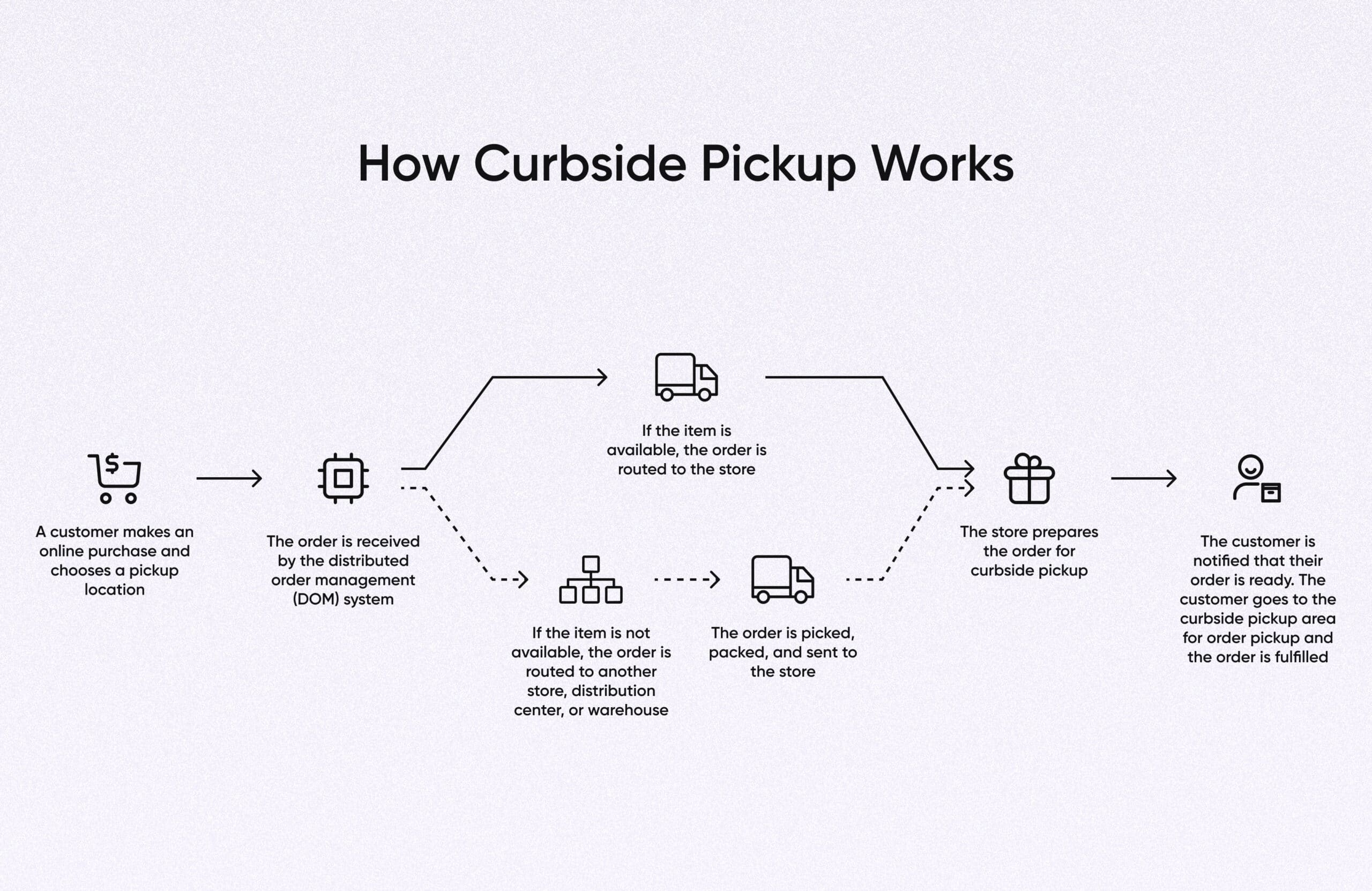
Curbside pickup is fairly straightforward for the retailer and consumer — here’s how it works at a high level:
1. A customer makes a purchase online
The curbside pickup process kicks off when a customer places an order on a retailer’s website or mobile app. At checkout, the customer indicates that they want to use curbside pickup and can select a pickup time and store that best fits their location and schedule.
For curbside pickup to work, retailers must integrate in-store and online inventory tracking systems to set up real-time inventory controls and reduce the chances of an item being out of stock when a customer tries to take advantage of curbside pickup.
2. The order is received by the OMS and order processing begins
Order processing is the series of steps that a business follows to fulfill a customer’s purchase in a fast, efficient manner. A distributed order management (DOM) system will begin processing the order by routing it to the desired location according to the business logic or rules set by the retailer. The store, fulfillment center, or distribution center may be closest to the shopper, or have the most or least inventory, or have some other reason for being the optimal fulfillment location.
3. The order is routed to the store for fulfillment
If the item is in stock, the DOM system routes the order to the designated store.
3A. The order is routed to a different facility for fulfillment
If the item is not in stock, the DOM system routes the order to a different store, distribution center, or warehouse facility, where the item is picked, packed, and then sent to the designated store.
4. The store prepares the order for pickup
If the item is in stock, store associates can use a store fulfillment app to fulfill orders and manage order fulfillment workflow. They will pick and pack the item and prepare it for pickup. If the item is routed to the store from a different location, the order is simply prepared for pickup.
5. The customer is notified that their order is ready for curbside pickup
A notification is sent to the customer, letting them know that their order is available for pickup at their convenience. Communications will generally include instructions regarding where the customer should park to pick up the order—often, these parking spots are clearly marked and numbered.
6. The customer completes order pickup
When customers arrive in one of the curbside parking spots, an associate will ask them to present a QR code, text, or confirmation email. Once the order is scanned, the customer service representative (CSR) will either hand the order to the customer or place the items in the trunk or back seat and the order is fulfilled.
Benefits of Curbside Pickup
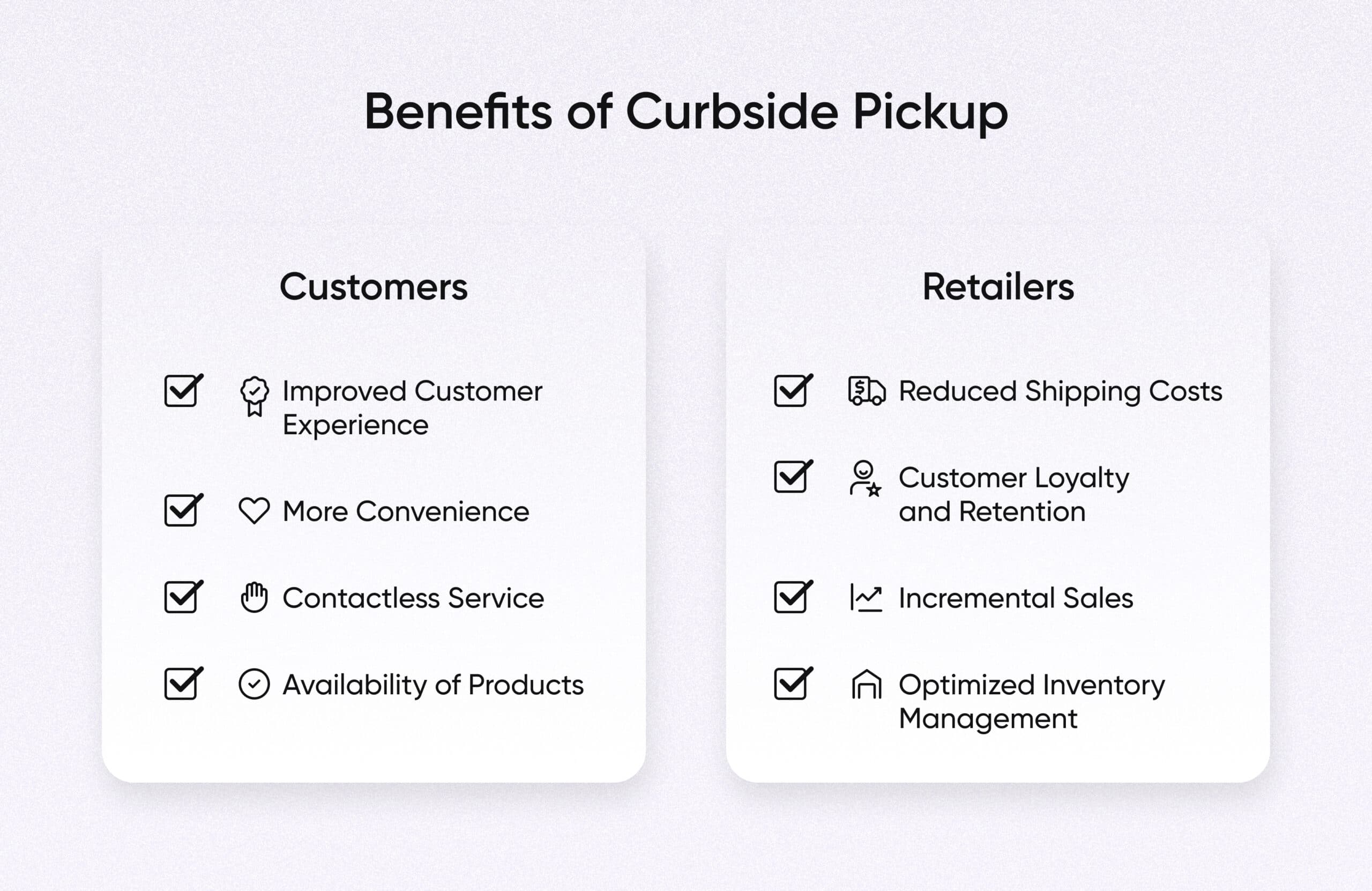
For customers
Both retailers and consumers gain significant advantages from curbside pickup. Some of the main benefits to customers include:
Enhanced shopping experience
Customers can choose when and where to pick up their orders and don’t even have to leave their cars. Sometimes they can pick up their order the same day they place it, allowing retailers to give them the same near-instant gratification that competitors like Amazon provide.
Convenience
Curbside pickup is often faster and more convenient than in-store shopping—especially if stores are busy. Customers don’t need to navigate aisles or wait in line. According to PYMTS, added convenience has made the US the “largest and fastest-growing pickup economy,” with 16.4 million consumers retrieving their most recent online purchases via in-store or curbside pickup.
Reduced contact
Contactless service remains a safe way for customers with health concerns or disabilities to receive their orders, eliminating the need to touch surfaces, shopping carts, and product packaging.
Increased inventory availability
In cases where certain items might be out of stock for traditional delivery due to logistical constraints, temporary unavailability, or other factors, customers may have the option to retrieve them in a timely manner via curbside pickup. This offers customers a wider availability of products.
For retailers
E-commerce retailers can reap many benefits from offering curbside pickup as well, such as:
Reduced shipping costs
The cost of shipping is the #1 challenge for e-commerce merchants today. 41% of merchants said the cost of shipping was their biggest challenge in 2022 and 36% said that will continue in 2023. With curbside pickup, retailers don’t need to pay for the packaging and logistics of last-mile delivery, resulting in cost savings that can be passed down to the consumer.
Customer loyalty and retention
The flexibility, lack of shipping costs, and time-savings of curbside pickup yield higher customer satisfaction rates and, perhaps more importantly, drive customer loyalty and retention. Happy customers are more likely to use the curbside pickup service again and may even make it part of their everyday routine.
Incremental sales
Offering curbside pickup as an option allows businesses to capture incremental sales. Retailers often fear that click-and-collect options will cannibalize store sales but generally the opposite happens.
For example, Walgreens offers 30-minute pickups, as well as drive-thru and curbside pickup options, and they completed 35 million pickup orders and one-hour deliveries from its stores in 2022. Walgreens was originally concerned that digital orders might “cannibalize the store”. According to Lindsay Mikos, Walgreens’ senior director of retail omnichannel:
“That’s always been the biggest fear, but it doesn’t. It actually drives incremental value. They spend more money with us. We’re able to engage with them more often and give them more relevant offers.”
Optimized inventory management
Curbside pickup significantly enhances inventory management for retailers, especially when it’s being orchestrated by a distributed order management (DOM) system. By leveraging real-time data and seamless coordination between online and in-store channels, retailers can efficiently track stock levels across multiple locations across the network.
If an item is not available in-store for fulfillment, advanced order routing can use order fulfillment logic (OFL) to route orders to nearby stores or warehouses quicker. Meanwhile, network aggregation can create pools of inventory across multiple locations for enhanced visibility and availability. This helps retailers optimize inventory allocation, prevent stockouts, and better fulfill customer orders.
Challenges of Curbside Pickup
While curbside pickup has major advantages, it also has some potential drawbacks, including:
Parking setup
Not all retail locations are suitable for curbside pickup, perhaps due to lack of space, awkward layouts, or other location-specific reasons. Additionally, reserved curbside pickup spots need to be close enough to a store entrance that it’s easy for CSRs to get outside but not so close that they block or interfere with regular store traffic or cause parking lot congestion. Retailers can use signage to make curbside parking spots immediately visible so customers know exactly where to go.
Staff training
Unless you onboard more staff, store associates will be doing double duty, helping customers in-store and with order fulfillment for curbside pickup. Limited staff training could lead to errors, delays, crowded parking lots, or unpleasant in-store or curbside pickup experiences—all of which impact customer loyalty. Retailers should consider rolling out a robust training program at all store locations to ensure that staff members know how to receive, pick, and pack orders, send customer notifications, verify customer information, and hand orders off to the customer.
Operational complexity
Offering curbside pickup involves many moving parts, including online ordering, inventory management, order fulfillment, and customer communications. Integrating your e-commerce platform and your order and inventory management system is critical for efficient curbside pickup operations.
Technology plays a huge role in addressing these challenges. Oftentimes, legacy retail technology is not user friendly, which makes it hard for associates to complete their tasks.
Investing in an order management system with distributed order management (DOM) capabilities will provide you with optimized order lifecycle management, enhanced inventory visibility across the network, strong inventory controls, customizable fulfillment logic for advanced order orchestration and routing, and support for omnichannel fulfillment options such as curbside pickup and BOPIS. Additionally, a store fulfillment app can improve store-level operational efficiency and provide greater inventory visibility, accelerate pick and pack velocity, and provide advanced order orchestration to optimize fulfillment.
Best Practices for Implementing Curbside Pickup
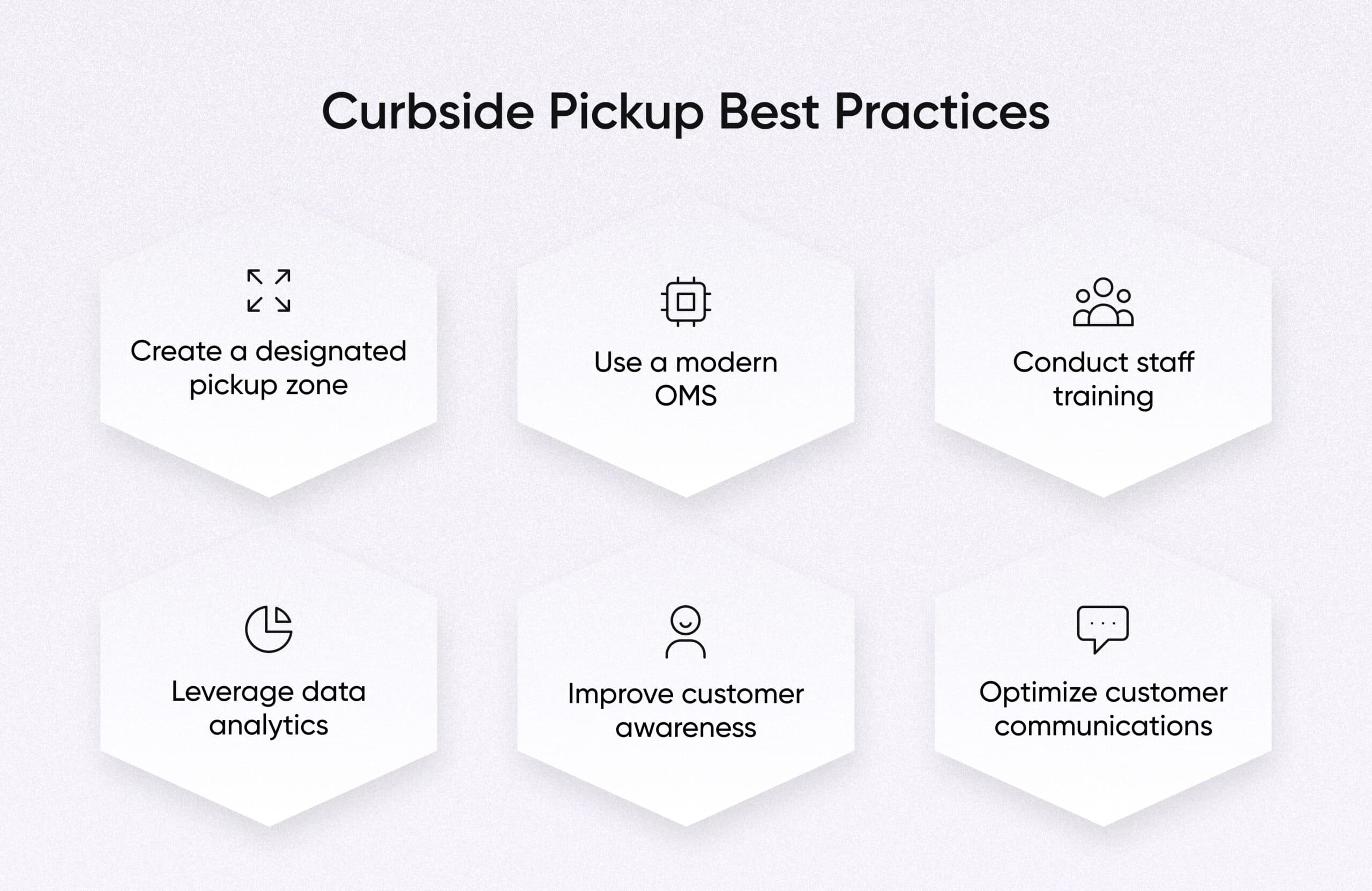
Successfully implementing curbside pickup requires a well-thought-out strategy. By following the best practices below, you can build a successful and streamlined curbside pickup experience for both customers and staff:
- Create a designated pickup zone: Retailers want to designate a specific area for curbside pickup that is easily accessible and visible to customers. Companies want to ensure that this area is clearly visible, well-marked with signs, and efficiently organized to accommodate multiple vehicles simultaneously. It should also not interrupt parking lot flow or block access for in-store customers. The decision to expand, contract, or move the curbside pickup zone will depend on how quickly and efficiently it serves customer demand.
- Use a modern OMS and a store fulfillment app: Today’s modern OMS software allows retailers to manage inventory, orders, and fulfillment with a single system. It can provide real-time visibility into inventory levels across your network, enable accurate order processing, and reduce the risk of stockouts. Additionally, a DOM system facilitates advanced order routing and allocation, ensuring that curbside pickup orders are fulfilled with inventory from the nearest available source, whether it’s from a warehouse, distribution center, or other store. This further enhances the speed and convenience for customers. Also, a store fulfillment application can streamline omnichannel fulfillment workflows and empower retail store associates to offer modern fulfillment options, such as curbside pickup and BOPIS.
- Conduct comprehensive staff training: Employees play a significant role in the e-commerce customer journey. You can educate and train your employees on every aspect of curbside pickup operations with special attention paid to customer service, brand image, safety, and efficiency. Dedicating a portion of staff exclusively to curbside pickup can also speed up the picking, packing, and customer handoff process.
- Leverage data analytics: Data analytics play a vital role in optimizing curbside pickup operations. Retailers can analyze data for customer behavior, order patterns, and peak pickup times, which can be used to make informed decisions to optimize staffing levels, predict inventory demands, and allocate resources effectively.
- Improve customer awareness: According to Digital Commerce 360, one major area of improvement across e-commerce retail is general awareness of curbside pickup offerings. Retailers should encourage customers to use curbside pickup and create awareness of this fulfillment option, which may require marketing efforts and better website design to drive adoption and change customer behavior. They can also make continuous improvements to staff training by soliciting feedback and assessing in-store KPIs.
- Optimize customer communications: Customers and CSRs need to have clear, timely, and effective communications for curbside pickup to work seamlessly. For full transparency, instructions for pickup, order status notifications, potential delays, and other updates must be sent quickly to customers through email, SMS, or app notifications.
fabric OMS Supports Curbside Pickup and Omnichannel Fulfillment
When done well, curbside pickup can stimulate more frequent purchases and lead to greater customer loyalty. It also acts as a forcing function for more cost-efficient inventory management and in store operations, lowering overall costs to enterprise retailers. But achieving that level of efficiency and customer satisfaction isn’t possible without the right tech solution.
fabric OMS is a distributed order management system built specifically for enterprise retail brands committed to providing excellent fulfillment experiences. fabric’s modular order orchestration software scales with the retailer to support any modern omnichannel fulfillment model, from curbside pickup, to BOPIS, to ship-to-store, and more.
Users can also configure and update order fulfillment logic without developer assistance. With fabric OMS, you can manage the entire order lifecycle from a single, intuitive interface, giving you and your team time to focus on strategic initiatives.
Ready to simplify and scale? Schedule a fabric OMS demo today.
Curbside Pickup FAQ
What is the meaning of curbside pickup?
Curbside pickup is a convenient fulfillment option where customers can place online orders and collect their purchases without entering a retailer’s physical store. During checkout, the customer chooses from a list of days and times for pickup. Customers drive to a curbside pickup area where store associates deliver their orders directly to their vehicles.
Curbside pickup is a contactless, efficient, and flexible solution for busy customers. Retailers benefit from decreased shipping costs, improved inventory management, and better customer satisfaction and loyalty.
What’s the difference between in-store pickup and curbside pickup?
In-store pickup requires customers to enter a brick-and-mortar store to collect their online purchases. When customers arrive, they go to a pickup counter or service area, where store associates will verify their order before handing it over. With in-store pickup, customers are encouraged to browse the store and potentially make additional purchases.
Curbside pickup is a more convenient, contactless alternative. Customers still place their orders online but drive to a curbside pickup area to collect their orders instead of entering the store. Store associates bring orders directly to the customer’s vehicle, making it an easy choice for customers who prefer minimal contact or have time constraints.
What is the purpose of curbside pickup?
The purpose of curbside pickup is to offer a convenient, efficient, and contactless fulfillment option. Curbside pickup allows businesses to meet rising consumer expectations for quick and easy fulfillment experiences. Customers can choose when and where to pick up their items and don’t even have to leave their car. With curbside pickup, there are no shipping costs, and customers know their order will be available upon pickup.
What are some more examples of curbside pickup?
Sam’s Club first implemented curbside pickup at 16 clubs before launching to all 597 clubs nationwide. The company recently rolled back its free curbside-pickup option for regular Club members but the benefit is still free for Sam’s Club Plus members.
Southeastern Grocers recently launched curbside pickup at roughly 300 Winn-Dixie and Harveys stores, citing additional convenience to its customers as the driving factor behind the decision. They paired their launch with $10 donations to local food bank partners for every curbside order.
Postmates has added curbside pickup as a delivery option for its restaurant partners. Restaurants that opt in can handle orders curbside, maximizing space inside the location and minimizing disruption to kitchen operations.
Digital content editorial team @ fabric.
